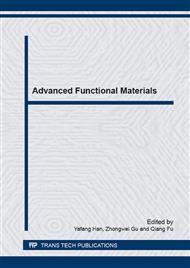[1]
V. Marques, C. Johnston, P. Grant. Nanomechanical characterization of Sn–Ag–Cu/Cu joints—Part 1: Young's modulus, hardness and deformation mechanisms as a function of temperature. Acta Mater. 61 (2013) 2460-70.
DOI: 10.1016/j.actamat.2013.01.019
Google Scholar
[2]
V. Marques, B. Wunderle, C. Johnston, P. Grant. Nanomechanical characterization of Sn–Ag–Cu/Cu joints—Part 2: Nanoindentation creep and its relationship with uniaxial creep as a function of temperature. Acta Mater. 61 (2013) 2471-80.
DOI: 10.1016/j.actamat.2013.01.020
Google Scholar
[3]
L. Jiang, N. Chawla. Mechanical properties of Cu6Sn5 intermetallic by micropillar compression testing. Scr. Mater. 63 (2010) 480-3.
DOI: 10.1016/j.scriptamat.2010.05.009
Google Scholar
[4]
Y. Kanda, Y. Kariya, Y. Oto. Influence of cyclic strain-hardening exponent on fatigue ductility exponent for a Sn-Ag-Cu micro-solder joint. J. Electron. Mater. 41 (2012) 580-7.
DOI: 10.1007/s11664-011-1830-7
Google Scholar
[5]
X. Deng, N. Chawla, K. Chawla, M. Koopman. Deformation behavior of (Cu, Ag)–Sn intermetallics by nanoindentation. Acta Mater. 52 (2004) 4291-303.
DOI: 10.1016/j.actamat.2004.05.046
Google Scholar
[6]
N. Fleck, J. Hutchinson. A reformulation of strain gradient plasticity. J. Mech. Phys. Solids 49 (2001) 2245-71.
Google Scholar
[7]
S. Shim, H. Bei, E. P. George, G.M. Pharr. A different type of indentation size effect. Scr. Mater. 59 (2008) 1095-8.
DOI: 10.1016/j.scriptamat.2008.07.026
Google Scholar
[8]
M. Lodes, A. Hartmaier, M. Göken, K. Durst. Influence of dislocation density on the pop-in behavior and indentation size effect in CaF2 single crystals: Experiments and molecular dynamics simulations. Acta Mater. 59 (2011) 4264-73.
DOI: 10.1016/j.actamat.2011.03.050
Google Scholar
[9]
P. Sadrabadi, K. Durst, M. Göken. Study on the indentation size effect in CaF2: Dislocation structure and hardness. Acta Mater. 57 (2009) 1281-9.
DOI: 10.1016/j.actamat.2008.11.015
Google Scholar
[10]
W.D. Nix, H. Gao. Indentation size effects in crystalline materials: a law for strain gradient plasticity. J. Mech. Phys. Solids 46 (1998) 411-25.
DOI: 10.1016/s0022-5096(97)00086-0
Google Scholar
[11]
Y. Wang, W. Liu, Y. Ma, Y. Huang, Y. Tang, F. Cheng, et al. Indentation size effect and micromechanics characterization of intermetallic compounds in the Au-Sn system. Mater. Sci. Eng: A 610 (2014) 161–170.
DOI: 10.1016/j.msea.2014.05.039
Google Scholar
[12]
Y. Wang, W. Liu, Y. Ma, Y. Huang, Y. Tang, H. Luo , et al. Indentation depth dependent micromechanical properties and rate dependent pop-in events of (Au, Cu)5Sn. Mater. Lett. 131 (2014) 57–60.
DOI: 10.1016/j.matlet.2014.05.166
Google Scholar
[13]
Y. Wang, W. Liu, Y. Ma, Y. Huang, Y. Tang, F. Cheng. Indentation size effect of stress exponent and hardness in homogeneous duplex eutectic 80Au/20Sn. Mater. Lett. 120 (2014) 151-4.
DOI: 10.1016/j.matlet.2014.01.066
Google Scholar
[14]
W.C. Oliver, G.M. Pharr. An improved technique for determining hardness and elastic modulus using load and displacement sensing indentation experiments. J. Mater. Res. 7 (1992) 1564-83.
DOI: 10.1557/jmr.1992.1564
Google Scholar
[15]
N. Yu, A.A. Polycarpou, T.F. Conry. Tip-radius effect in finite element modeling of sub-50 nm shallow nanoindentation. Thin Solid Films 450 (2004) 295-303.
DOI: 10.1016/j.tsf.2003.10.033
Google Scholar
[16]
Y. H uang, F. Zhang, K. Hwang, W. Nix, G. Pharr, G. Feng. A model of size effects in nano-indentation. J. Mech. Phys. Solids 54 (2006) 1668-86.
DOI: 10.1016/j.jmps.2006.02.002
Google Scholar
[17]
G. Feng, W.D. Nix. Indentation size effect in MgO. Scr. Mater. 51 (2004) 599-603.
Google Scholar
[18]
H. Bei, Y. Gao, S. Shim, E.P. George, G.M. Pharr. Strength differences arising from homogeneous versus heterogeneous dislocation nucleation. Phys. Rev. B 77 (2008) 060103.
DOI: 10.1103/physrevb.77.060103
Google Scholar
[19]
G. Liu, M. Song, X. Liu, S. Ni, S. Wang, Y. He, et al. An investigation of the mechanical behaviors of micro-sized tungsten whiskers using nanoindentation. Mater. Sci. Eng: A 594 (2014) 278-86.
DOI: 10.1016/j.msea.2013.11.084
Google Scholar
[20]
D. Lorenz, A. Zeckzer, U. Hilpert, P. Grau, H. Johansen, H. Leipner. Pop-in effect as homogeneous nucleation of dislocations during nanoindentation. Phys. Rev. B 67 (2003) 172101.
DOI: 10.1103/physrevb.67.172101
Google Scholar
[21]
P. Huang, F. Wang, M. Xu, K. Xu, T. Lu. Dependence of strain rate sensitivity upon deformed microstructures in nanocrystalline Cu. Acta Mater. 58 (2010) 5196-205.
DOI: 10.1016/j.actamat.2010.05.055
Google Scholar
[22]
M. Kerr, N. Chawla. Creep deformation behavior of Sn–3. 5 Ag solder/Cu couple at small length scales. Acta Mater. 52 (2004) 4527-35.
DOI: 10.1016/j.actamat.2004.06.010
Google Scholar


